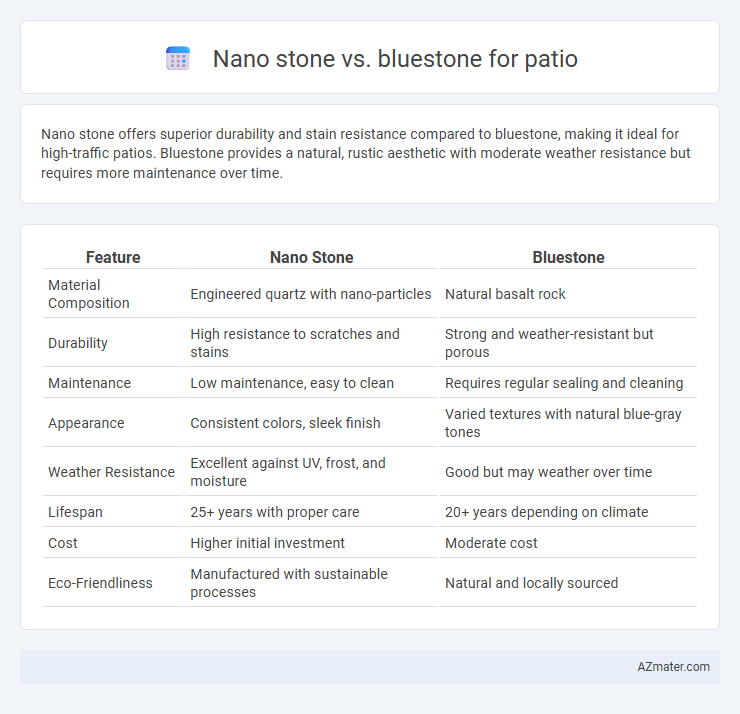Nano stone offers superior durability and stain resistance compared to bluestone, making it ideal for high-traffic patios. Bluestone provides a natural, rustic aesthetic with moderate weather resistance but requires more maintenance over time.
Table of Comparison
| Feature | Nano Stone | Bluestone |
|---|---|---|
| Material Composition | Engineered quartz with nano-particles | Natural basalt rock |
| Durability | High resistance to scratches and stains | Strong and weather-resistant but porous |
| Maintenance | Low maintenance, easy to clean | Requires regular sealing and cleaning |
| Appearance | Consistent colors, sleek finish | Varied textures with natural blue-gray tones |
| Weather Resistance | Excellent against UV, frost, and moisture | Good but may weather over time |
| Lifespan | 25+ years with proper care | 20+ years depending on climate |
| Cost | Higher initial investment | Moderate cost |
| Eco-Friendliness | Manufactured with sustainable processes | Natural and locally sourced |
Introduction to Nano Stone and Bluestone
Nano Stone offers a cutting-edge composite material that combines durability and sleek aesthetics ideal for modern patios, featuring enhanced resistance to weathering and stains. Bluestone, a natural sedimentary rock known for its rich blue-gray hues and textured surface, provides timeless elegance and exceptional slip resistance suited for outdoor spaces. Choosing between Nano Stone and Bluestone depends on preferences for low maintenance and uniformity versus natural variation and classic appeal.
Composition and Characteristics
Nano stone features engineered quartz and resin, offering a non-porous, scratch-resistant surface ideal for low-maintenance patios. Bluestone, a natural sedimentary rock primarily composed of feldspar and quartz, provides a durable, slip-resistant surface with unique color variations and a textured finish. Both materials vary in heat retention and weather resistance, with Nano stone excelling in uniformity and Bluestone favored for its natural aesthetic and strength.
Aesthetic Appeal: Looks and Colors
Nano stone offers a sleek, contemporary aesthetic with smooth textures and subtle color variations in neutral tones like grays and beiges, enhancing modern patio designs. Bluestone, known for its natural, rustic charm, features rich blue-gray hues with unique veining and surface irregularities, providing a timeless, organic appearance. The choice between Nano stone and Bluestone depends on whether a clean, minimalistic look or a classic, natural stone ambiance is preferred for the patio space.
Durability and Weather Resistance
Nano stone offers superior durability and enhanced weather resistance compared to bluestone, making it ideal for patios exposed to harsh climates. Its dense, non-porous surface resists cracking, fading, and water absorption, ensuring longevity under freeze-thaw cycles and heavy rainfall. Bluestone, while naturally strong and aesthetically pleasing, tends to be more porous and susceptible to surface erosion over time in extreme weather conditions.
Surface Texture and Slip Resistance
Nano stone patios offer a smooth, polished surface texture that enhances modern aesthetics while providing moderate slip resistance, suitable for dry conditions. Bluestone features a naturally rough, textured finish that increases slip resistance, making it ideal for wet or high-traffic areas. The choice between nano stone and bluestone for patio surfaces depends on balancing desired visual appeal with safety requirements related to slip resistance.
Installation Process and Ease
Nano stone patios offer a streamlined installation process due to their lightweight composition and uniform thickness, making them easier to handle and fit together precisely. Bluestone requires more labor-intensive preparation, including uneven surface leveling and cutting heavier, thicker slabs to size, which can extend installation time and complexity. Homeowners typically find nano stone faster and less physically demanding to install, resulting in lower labor costs and quicker project completion.
Maintenance and Cleaning Requirements
Nano stone patios require minimal maintenance due to their non-porous surface, which resists stains and prevents mold growth, making cleaning quick with just water and mild soap. Bluestone, being porous, demands regular sealing every 1-2 years to protect against moisture absorption and staining, and cleaning involves scrubbing with a brush and pH-neutral cleaners to remove dirt and prevent algae buildup. Both materials benefit from prompt stain removal, but nano stone offers a more hassle-free upkeep ideal for low-maintenance outdoor spaces.
Cost Comparison and Long-Term Value
Nano stone patios typically cost more upfront due to advanced manufacturing processes but offer superior durability and stain resistance, reducing maintenance expenses over time. Bluestone is generally more affordable initially, with moderate upkeep costs, yet may require more frequent sealing and repairs, impacting long-term value. Evaluating lifetime expenses, nano stone often provides better return on investment through enhanced longevity and lower maintenance needs.
Environmental Impact and Sustainability
Nano stone offers a lower environmental footprint due to its manufacturing process, which typically involves recycled materials and energy-efficient methods, reducing carbon emissions. Bluestone is a natural quarried stone, making its extraction energy-intensive and potentially disruptive to ecosystems, although it is highly durable and can last for decades, minimizing long-term environmental impact. Both materials support sustainable landscaping when sourced responsibly, but nano stone's engineered properties often result in a greener overall profile compared to traditional bluestone patios.
Choosing the Right Stone for Your Patio
Nano stone offers a sleek, uniform appearance with high durability and low porosity, making it ideal for patios exposed to heavy traffic and varying weather conditions. Bluestone, characterized by its natural texture and rich blue-gray hues, provides excellent slip resistance and a timeless aesthetic that complements traditional and rustic outdoor spaces. Choosing the right stone depends on balancing factors like maintenance requirements, climate endurance, and the desired visual impact for your patio design.

Infographic: Nano stone vs Bluestone for Patio
 azmater.com
azmater.com